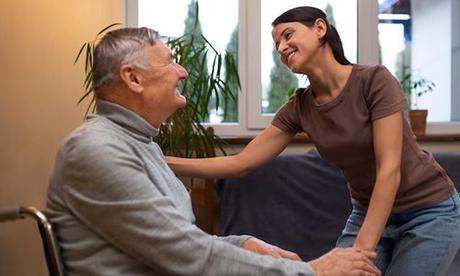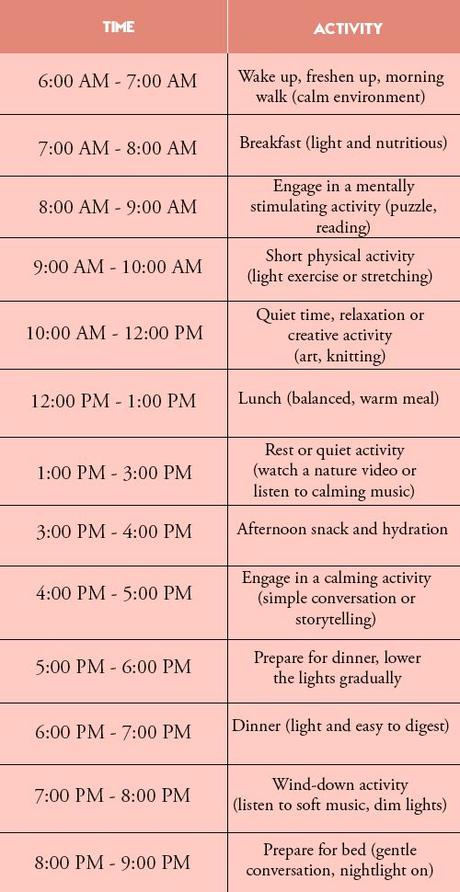Have you noticed that your loved one with dementia or Alzheimer's becomes more confused or agitated as the day turns into night? This phenomenon, known as sundowning, can be distressing for both the patient and the caregiver. It's not just the fading daylight that triggers these symptoms-there's much more going on. In this blog, we'll explain what sundowning is, what causes it, how to reduce its impact, and essential tips for caregivers.
Sundowning Causes

The exact cause of sundowning isn't entirely clear, but there are several theories about why this happens. Some of the common causes include:
1. Circadian Rhythm Disturbances
People with dementia often have altered internal body clocks, making it harder for them to distinguish between day and night.
As the day progresses, they may feel physically and mentally exhausted, which can lead to increased agitation.
3. Reduced Sensory Stimulation
As the sun sets and natural light fades, there's less visual stimulation, causing confusion and distress.
4. Hunger or Dehydration
Feeling hungry, thirsty, or uncomfortable from physical needs can also trigger or worsen symptoms of sundowning.
5. Unmet needs
Needs like going to the bathroom or being too hot or cold can also lead to frustration and confusion.
By understanding these causes, you're already a step closer to finding ways to reduce sundowning symptoms.
Sundowning Symptoms

Recognizing the symptoms of sundowning is the first step toward managing it. Some common symptoms include:
- Increased confusion or disorientation - The person may appear more disoriented or unable to understand where they are or who they're with.
- Agitation and Restlessness - Pacing, fidgeting, irritability, or general unease are common signs.
- Paranoia or hallucinations - The individual may perceive things that aren't real, such as seeing or hearing things or feeling suspicious of people or situations around them.
- Mood swings or shouting - The individual may experience sudden anger, irritability, or sadness.
- Difficulty sleeping: Many individuals will have trouble falling asleep or staying asleep during the night.
- Shadowing: Some may follow caregivers closely, feeling insecure or anxious without them nearby.
These symptoms often start in the late afternoon and get worse as the evening progresses. But recognizing them is the first step toward addressing these symptoms.
Factors That Worsen the Symptoms

Sometimes, without realizing it, we may contribute to the worsening of sundowning symptoms. Being aware of these factors can help in managing their condition better.
1. Overstimulation
Too much noise, activity, bright lights, or more visitors in the evening can increase confusion.
2. Too Much Caffeine or Sugar Intake
Consuming caffeinated drinks or sugary foods too late in the day can trigger restlessness.
3. Napping During the Day
Long or frequent naps during the day can disrupt sleep at night, worsening sundowning symptoms.
4. Disrupted Routine
Changes in their daily schedule, such as late appointments or irregular mealtimes, can be disorienting.
5. Poor Lighting
Not only bright lights but dim or flickering lights can also increase confusion and anxiety.
Mistakes to Avoid That Worsen Sundowning

While caring for someone experiencing sundowning, a few mistakes can unintentionally make things worse. Here are a few common pitfalls:
1. Ignoring the Signs
Dismissing early signs of confusion or agitation can cause symptoms to escalate quickly.
2. Arguing or Correcting
When someone is disoriented, correcting them or arguing may increase their frustration and anxiety.
3. Overstimulating
Not only them, even if you're watching loud television shows or engaging in activities that are too stimulating in the late afternoon, can trigger symptoms.
4. Making Sudden Changes in Their Environment
Moving the person to a new room or changing their surroundings without warning can cause further disorientation.
5. Neglecting Self-Care
Caregivers who neglect their own needs may feel overwhelmed, leading to unintentional mistakes in the patient's care.
By avoiding these mistakes, you can create a more calming environment for your loved one.
Pro Tips for Reducing Sundowning
Look at some of the practical ways to reduce sundowning.
- Maintain regular wake-up, meal, and bedtimes.
- Keep rooms well-lit in the afternoon to prevent shadows and gradually dim the lights in the evening.
- Short, scheduled naps can prevent nighttime wakefulness .
- Gentle music, a relaxing massage, or quiet time together can help them feel more grounded.
- Offer them balanced and nutritious meals.
When to Seek Doctor's Help

It's important to know when sundowning needs professional attention. If symptoms are severe, frequent, or are leading to aggressive behavior, it might be time to consult a healthcare provider. They can assess for any underlying issues, such as pain or medication side effects, that might contribute to sundowning.
Treatment for Sundowner's Syndrome
Though there is no specific cure for Sundowner's Syndrome, several treatments can help reduce symptoms and improve the quality of life for the patients.
1. Medications

In some cases, medications may be necessary to help manage sundowning symptoms. A doctor must prescribe these medications and are usually used as a last resort.
- Sleep Aids: Medications like melatonin or other prescribed sleep aids can help regulate sleep patterns. Melatonin is a natural hormone that may improve sleep-wake cycles in dementia patients.
- Anti-Anxiety Medications: For patients experiencing severe agitation, a doctor might prescribe mild anti-anxiety medications. These should be used carefully, as they may have side effects.
- Antipsychotic Medications: In rare cases, antipsychotic drugs may be prescribed to control aggressive or highly disruptive behaviors. These should only be used under strict medical supervision.
2. Cognitive Behavioral Therapy (CBT)

CBT can help patients and caregivers better understand and manage the anxiety and confusion associated with sundowning. A trained therapist can offer coping strategies and relaxation techniques that are beneficial for both the patient and their caregivers.
3. Light Therapy

Bright light therapy has been shown to help regulate circadian rhythms and reduce symptoms of sundowning. By exposing the person to bright light in the morning or throughout the day, you can help "reset" their internal body clock, improving sleep patterns and reducing evening confusion.
4. Music and Aromatherapy

These non-invasive therapies have shown promise in reducing agitation and anxiety in dementia patients. Music therapy or using calming scents like lavender in the evening can help create a more peaceful environment, easing the transition into nighttime.
What Are the Ways to Help Someone in Sundowning
Caring for someone during a sundowning episode can be tough, but here are some things you can do:
1. Staying calm

Speaking softly, using gentle gestures, and staying with the patient can help ease their distress and make them feel more secure.
2. Redirecting Their Attention

If they become restless or agitated, try gently shifting their focus to a calming activity, like folding clothes, looking at family photos, or listening to . These simple tasks can serve as comforting distractions.
3. Providing Reassurance

Offering verbal reassurances, such as reminding them they are safe, can help reduce feelings of fear. If they are comfortable with physical touch, holding their hand or giving a gentle hug can provide additional comfort and grounding.
4. Planing Enough Breaks

Arrange for respite care or ask for help from family members or friends to give yourself time to recharge, ensuring you can provide the best care possible.
5. Joining a Support Group

Connecting them or yourself with a support group can be incredibly beneficial. Sharing experiences with others who are in similar situations offers emotional support, practical advice, and a sense of community, making it easier to manage the challenges of caregiving.
The goal is to help them feel safe and secure as their world feels more confusing in the evenings.
Caregiver's Daily Routine Planner
Maintaining a regular daily routine is one of the best strategies to minimize sundowning. Below is a simple daily routine planner designed to help caregivers structure the day, ensuring a balanced mix of physical activity, rest, and calming moments

Sundowning can be difficult to manage, but with understanding, patience, and the right strategies, it is possible to reduce its impact on the person and their caregivers. Remember, it's essential to take care of yourself, too. Seek professional advice when necessary, and don't hesitate to ask for help.

Emma is a dietitian who uses her background in medicine to write health blogs . She has a Master's degree in Dietetics and Nutrition. Emma is engaged in a variety of research projects on fitness, skincare, and mental wellness. For quick healthy advice, see Emma's posts.

